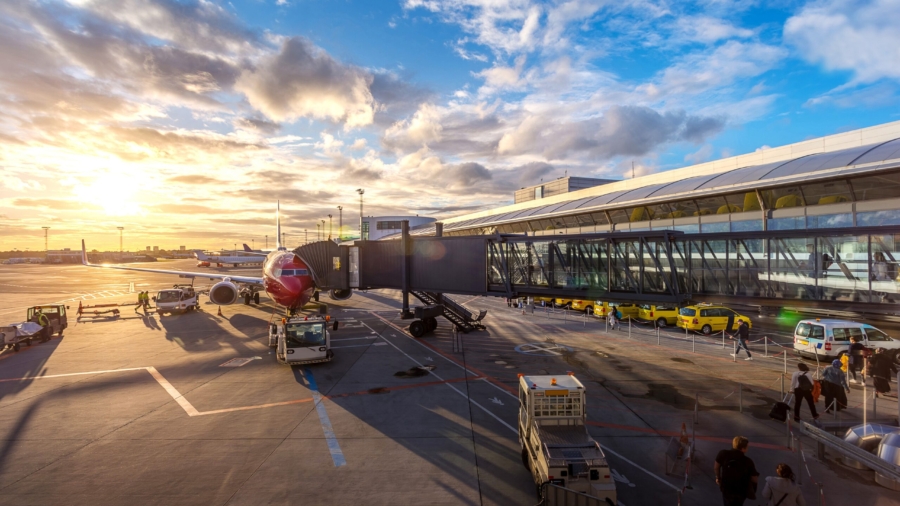Taking a look at the World’s first Solar powered Airport
The sun and its energy have always been ordained as an absolute necessity for the functioning of life on Earth. It is this same necessity that an airport in the state of Kerala, Cochin International Airport Limited (CIAL), has used as a trump card in its journey towards sustainable development.
A report by the International Energy Agency (IEA) states that Global Solar Photovoltaics (PV) capacity is expected to nearly triple between 2022 and 2027, surpassing coal as the world’s largest source of power capacity. According to the analysis, there are signs of diversity in global PV supply chains, with new legislation in the United States and India anticipated to increase investment in solar manufacturing by up to USD 25 billion between 2022 and 2027 [3].
Solar energy has been prioritised in India’s National Action Plan on Climate Change, with the National Solar Mission being one of the primary missions. The Mission’s goal is to position India as a global leader in solar energy by fast developing regulatory conditions for solar technology dissemination across the country [11]. India’s Intended Nationally Determined Contributions (INDCs) objective is to attain around 40% of cumulative electric power installed capacity from non-fossil fuel-based energy resources by 2030 and to reduce the emission intensity of its GDP by 33 to 35% from 2005 levels. As of November 30th 2022, solar power installed capacity was around 61.97 GW [11]. By 2026, the Indian industry will be able to produce 100 gigatonnes (GW) of solar modules per year, allowing the country to become a net exporter of solar power. This will considerably help India’s goal of adding 500 GW of non-fossil energy capacity by 2030, according to Bhupinder Bhalla, Secretary, Ministry of New and Renewable Energy [5].
Solar Energy in India’s Aviation Sector
India has set itself an ambitious goal of being the third-largest economy by 2030 and a $5 trillion economy by 2024–25. To reach the targets, there needs to be an increased focus on sustainable growth, which must address climate change issues and accomplish the Sustainable Development Goals (SDGs). The government plans to install 500 GW of renewable energy by 2030, including 280 GW of solar power, with the goal of reducing the nation’s overall carbon impact [12]. The idea of adopting solar power as an option, even for the aviation industry, has been sparked by the desire to lessen reliance on fossil fuels. In order to meet the needs of a large number of passengers, modern airports use a lot of energy in their daily operations, leading to large amounts of carbon emissions [12].
The conversion of Cochin International Airport Limited (CIAL) into a fully solar-powered airport began in the year 2013. CIAL started with a 100kWp Pilot Plant and gradually increased its solar capacity until it became the ‘World’s first Airport to be totally powered by Solar Energy’ in 2015, with an installed capacity of 13.1MWp [6]. In the year 2018, CIAL was awarded the United Nations’ Champions of the Earth environmental award. S.Suhas IAS, the Managing Director at CIAL states that “CIAL’s development policy encompasses Total Sustainability Management (TSM). We try to explore every possible way to address climate change. CIAL which achieved power neutrality in 2015 now becomes a power surplus organisation, feeding approximately 4 crore units of excess power annually to the State grid. And with the help of the Government, we are sure that we can venture into more such projects in the near future” [6].
The following section of this article will look into the solar energy initiatives taken up by CIAL and other initiatives that support their sustainability agendas.
Innovative Initiatives by CIAL
1. Solar Energy
Solar power has been CIAL’s main focal point in its sustainable journey. At present, CIAL has 50 MWp of installed solar capacity. The airport produces surplus power which is supplied back to the grid. In accordance with a power banking module developed with the Kerala State Electricity Board (KSEB), CIAL contributes as much electricity as it generates throughout the day to the KSEB grid and “buys back” the power from KSEB as needed, particularly at night [1]. CIAL is the second largest energy producer in the state of Kerala, after the Kerala State Electricity Board (KSEB). In addition to maximising available land to install solar panels, CIAL has installed these panels on top of their car parking structure which is called solar carports.
Through its various solar PV systems at the airport, CIAL has produced more than 25 crore units of green energy to date. CIAL Infra purchased 35 acres of property in Payyannur, Northern Kerala, as part of its effort to expand its solar projects outside of CIAL premises, and built an 11.6 MWp solar plant there. This is the first terrain-based installation in India. The Payyannur solar farm was initially intended to be a “captive power plant” to help CIAL satisfy its growing energy needs. However, the Covid-19 outbreak derailed CIAL’s commercial ambitions and caused its energy consumption to slow down. As a result, this facility turned into an “Independent Power Plant ” (IPP) and the KSEB grid receives all of the energy produced by this plant [7]. This plant has so far generated approximately One Crore units of green power.
Relying upon solar energy for the entire functioning of the airport has enabled CIAL in lowering its carbon footprint by 1,60,000 metric tonnes [6]. This green energy initiative will reduce the amount of carbon dioxide emissions from coal-fired power stations over the next 25 years by more than 300,000 tons, which is the same as planting 3 million trees or not driving 750 million miles in automobiles [1].
2. Photovoltaic Agriculture
With the aid of solar panels, CIAL has initiated Photovoltaic Agriculture. In this procedure, vegetables are grown in vacant spaces between solar panels. The water that is used to wash these solar panels runs off to the vegetables in between, thereby reusing water. The crops are anticipated to alter the microclimates beneath PV modules by lowering the temperature, which boosts power generation efficiency. Additionally, the crop coverage between PV arrays will prevent soil erosion and lessen the amount of dust that collects on the PV module. Another benefit of the cultivation is that it slows weed development around the PV panel mounts [8]. These agro-photovoltaic operations have so far generated about 90 metric tonnes of pesticide-free vegetables [6].
Conclusion
In the current scenario of climate change and the associated challenges that the world faces today in association with climate change, renewable energy is a step in the right direction. Airports, especially international ones, are important to a country’s economic fabric but at the same time contribute to a country’s carbon footprint. CIAL taking up solar energy and venturing into renewable energy has provided both a greater opportunity and a boost to switch to green energy. Other airports would be able to install renewable energy with ample planning along with clearly laying out their sustainability agendas.
References
- P.S, J. ICAO ENVIRONMENTAL REPORT – Sustainable Alternative Fuels. https://www.icao.int/environmental-protection/Documents/EnvironmentalReports/2016/ENVReport2016_pg177-177.pdf. Accessed May 2, 2023
- How is the World’s first airport fully powered by Solar Energy faring over time. https://www.routesonline.com/airports/5427/cochin-international-airport/news/298663/how-is-the-worlds-first-airport-fully-powered-by-solar-energy-faring-over-time/. Accessed May 2, 2023
- International Energy Agency (IEA). Renewable Power’s growth is being turbocharged as countries seek to strengthen energy security – news. (2022). https://www.iea.org/news/renewable-power-s-growth-is-being-turbocharged-as-countries-seek-to-strengthen-energy-security. Accessed May 12, 2023
- Richardson, L. (2023, April 26). History of solar energy: Timeline & invention of solar panels: Energysage. https://news.energysage.com/the-history-and-invention-of-solar-panel-technology/. Accessed May 15th, 2023
- Koshy, J. (2023, February 20). India plans to Export Solar Power: Official. The Hindu. https://www.thehindu.com/sci-tech/energy-and-environment/india-to-be-net-exporter-of-solar-modules-by-2026-says-ministry-for-new-and-renewable-energy-official/article66528527.ece. Accessed May 16th, 2023
- CIAL’s green energy generation touches 25 Cr. Units. Cochin International Airport. https://www.cial.aero/news-Updates/CIAL-s-green-energy#:~:text=CIAL%20now%20has%20a%20total%20installed%20solar%20capacity%20of%2050%20MWp.&text=Till%20date%2C%20CIAL%20has%20generated,by%201%2C60%2C000%20Metric%20tonnes. Accessed May 16th, 2023
- SOLAR POWER PROJECTS. CIAL infrastructure. https://www.cialinfra.in/projects/solar%20power%20projects. Accessed May 16th, 2023
- Cochin Airport Scales up agri-voltaic farming with joint production of food and Energy. (2021, December 13). The New Indian Express. https://www.newindianexpress.com/states/kerala/2021/dec/13/cochin-airport-scales-up-agri-voltaic-farming-with-joint-production-of-food-and-energy-2395094.html. Accessed May 16th, 2023
- Small Hydro Electric Project (SHEP). CIAL Infrastructure. https://www.cialinfra.in/Projects/SMALL%20HYDRO%20ELECTRIC%20PROJECTS%20(SHEP). Accessed May 16th, 2023
- CIAL to commission its 1st Hydropower Project. (2021, October 24). https://www.hindustantimes.com/india-news/cial-to-commission-its-1st-hydropower-project-101635101042584.html. Accessed May 16th, 2023
- Current status: Ministry of new and renewable energy, government of India. (n.d.). https://mnre.gov.in/solar/current-status/#:~:text=Solar%20power%20installed%20capacity%20has,and%20has%20achieved%20grid%20parity. Accessed May 12th, 2023
- Solar fueling green transformation of Indian Aviation. (2022, December 12). ET EnergyWorld. https://energy.economictimes.indiatimes.com/news/renewable/opinion-solar-fueling-green-transformation-of-indian-aviation/96162613. Accessed May 25th, 2023

